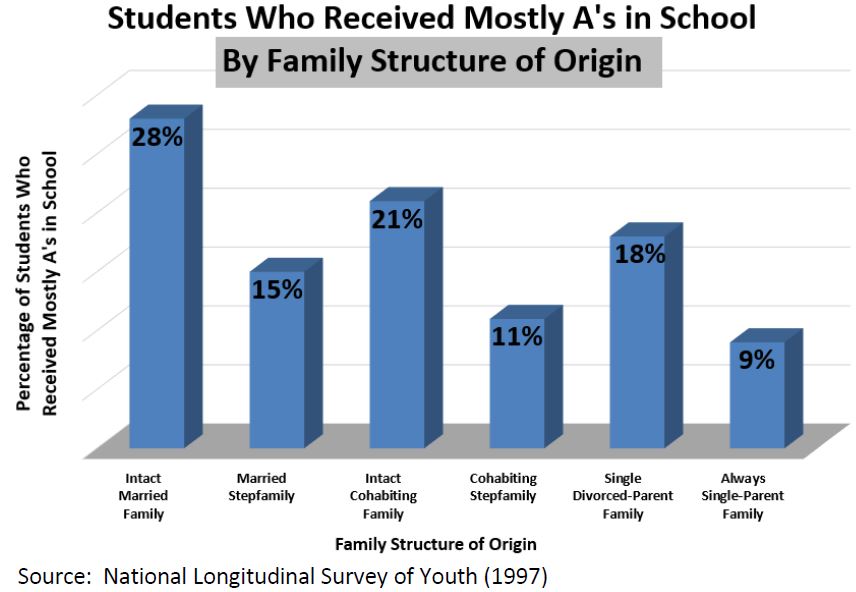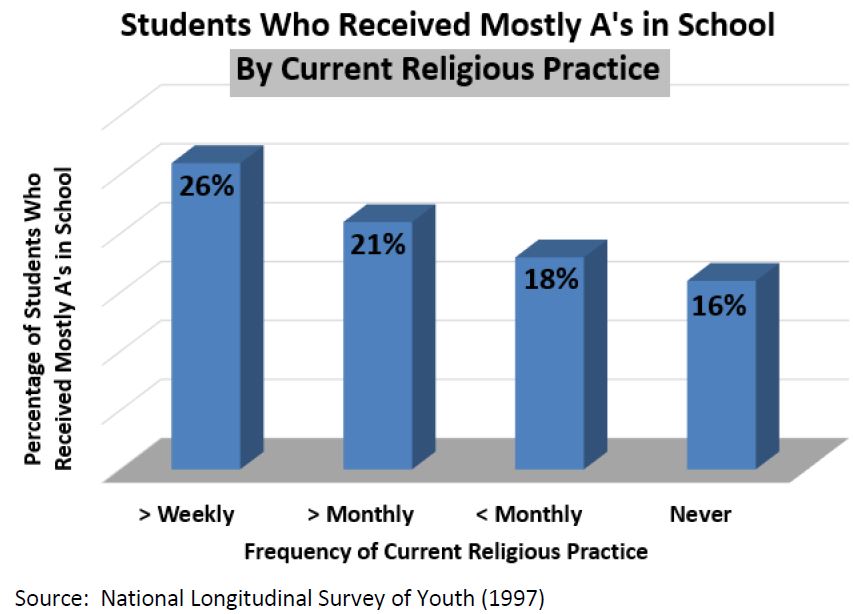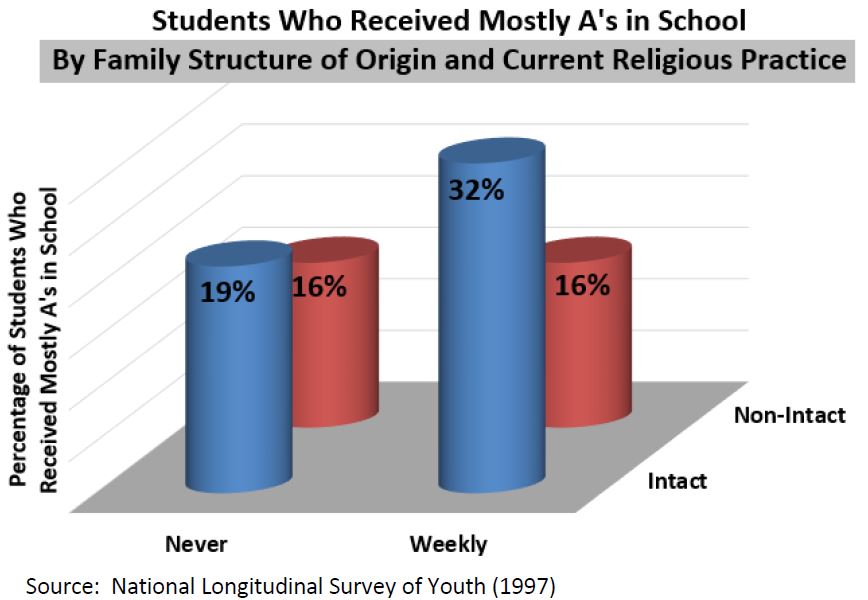Click Here to download “Students Who Received Mostly A’s in School by Family Structure and Religious Practice”
Students Who Received Mostly A’s in School by Family Structure and Religious Practice
The 1997 National Longitudinal Survey of Youth shows that students most likely to receive A’s in school were those who grew up in an intact married family and who worshipped at least weekly.
[1]
Family Structure: According to the 1997 National Longitudinal Survey of Youth, 28 percent of students who grew up in an intact married family received mostly A’s, followed by students from intact cohabiting families (21 percent), single divorced parent families (18 percent), married stepfamilies (15 percent), cohabiting stepfamilies (11 percent), and always single parent families (9 percent).
 Religious Practice:
Religious Practice: The National Longitudinal Survey of Youth showed that 26 percent of students who worshipped at least weekly [at the time of the survey] received mostly A’s, followed by those who attended religious services between one and three times a month (21 percent), those who attended religious services less than once a month (18 percent), and those who never attended religious services (16 percent).
 Family Structure and Religious Practice Combined:
Family Structure and Religious Practice Combined: About 32 percent of students who grew up in an intact married family and who worshipped at least weekly at the time of the survey received mostly A’s. Only 19 percent of students who grew up in intact married families and never worshipped received mostly A’s. Only 16 percent of those who grew up in other family structures and worshipped at least weekly or grew up in other family structures and never worshipped received mostly A’s.
 Related Insights from Other Studies:
Related Insights from Other Studies: One study showed that students who attended religious activities weekly, or more frequently, were found to have a GPA 14.4 percent higher than students who never attended religious functions.
[2]
Another study by Mark Regnerus, professor of sociology at the University of Texas at Austin, found that (looking specifically at math and reading scores) students who frequently attend religious services scored 2.32 points higher on tests in these subjects than their less religiously-involved peers.
[3]
Marital stability is a form of social capital that advances educational attainment for children. Thus, children from intact families have a greater chance at doing well in school, while divorce hinders a child’s overall educational attainment.
[4]
[1] These charts draw on data collected by the National Longitudinal Survey of Youth (1997).
[2] J. L Glanville, D. Sikkink, & E. I. Hernández, “Religious Involvement and Educational Outcomes: The Role of Social Capital and Extracurricular Participation,”
Sociological Quarterly 49 (2008): 105-137.
[3] Mark D. Regnerus, “Shaping Schooling Success: Religious Socialization and Educational Outcomes in Metropolitan Public Schools,”
Journal for the Scientific Study of Religion 39, no. 3 (2000): 363-70.
[4] Anguiano P. V. Ruben, “Families and Schools: The Effect of Parental Involvement on High School Completion,”
Journal of Family Issues 25, no. 1 (2004): 61-85; Timothy J. Biblarz & Greg Gottainer, “Family Structure and Children’s Success: A Comparison of Widowed and Divorced Single-Mother Families,”
Journal of Marriage and Family 62, (2000): 533-48.
]]>
 Religious Practice: The National Longitudinal Survey of Youth showed that 26 percent of students who worshipped at least weekly [at the time of the survey] received mostly A’s, followed by those who attended religious services between one and three times a month (21 percent), those who attended religious services less than once a month (18 percent), and those who never attended religious services (16 percent).
Religious Practice: The National Longitudinal Survey of Youth showed that 26 percent of students who worshipped at least weekly [at the time of the survey] received mostly A’s, followed by those who attended religious services between one and three times a month (21 percent), those who attended religious services less than once a month (18 percent), and those who never attended religious services (16 percent).
 Family Structure and Religious Practice Combined: About 32 percent of students who grew up in an intact married family and who worshipped at least weekly at the time of the survey received mostly A’s. Only 19 percent of students who grew up in intact married families and never worshipped received mostly A’s. Only 16 percent of those who grew up in other family structures and worshipped at least weekly or grew up in other family structures and never worshipped received mostly A’s.
Family Structure and Religious Practice Combined: About 32 percent of students who grew up in an intact married family and who worshipped at least weekly at the time of the survey received mostly A’s. Only 19 percent of students who grew up in intact married families and never worshipped received mostly A’s. Only 16 percent of those who grew up in other family structures and worshipped at least weekly or grew up in other family structures and never worshipped received mostly A’s.
 Related Insights from Other Studies: One study showed that students who attended religious activities weekly, or more frequently, were found to have a GPA 14.4 percent higher than students who never attended religious functions.[2]
Another study by Mark Regnerus, professor of sociology at the University of Texas at Austin, found that (looking specifically at math and reading scores) students who frequently attend religious services scored 2.32 points higher on tests in these subjects than their less religiously-involved peers.[3]
Marital stability is a form of social capital that advances educational attainment for children. Thus, children from intact families have a greater chance at doing well in school, while divorce hinders a child’s overall educational attainment.[4]
[1] These charts draw on data collected by the National Longitudinal Survey of Youth (1997).
[2] J. L Glanville, D. Sikkink, & E. I. Hernández, “Religious Involvement and Educational Outcomes: The Role of Social Capital and Extracurricular Participation,” Sociological Quarterly 49 (2008): 105-137.
[3] Mark D. Regnerus, “Shaping Schooling Success: Religious Socialization and Educational Outcomes in Metropolitan Public Schools,” Journal for the Scientific Study of Religion 39, no. 3 (2000): 363-70.
[4] Anguiano P. V. Ruben, “Families and Schools: The Effect of Parental Involvement on High School Completion,” Journal of Family Issues 25, no. 1 (2004): 61-85; Timothy J. Biblarz & Greg Gottainer, “Family Structure and Children’s Success: A Comparison of Widowed and Divorced Single-Mother Families,” Journal of Marriage and Family 62, (2000): 533-48.
]]>
Related Insights from Other Studies: One study showed that students who attended religious activities weekly, or more frequently, were found to have a GPA 14.4 percent higher than students who never attended religious functions.[2]
Another study by Mark Regnerus, professor of sociology at the University of Texas at Austin, found that (looking specifically at math and reading scores) students who frequently attend religious services scored 2.32 points higher on tests in these subjects than their less religiously-involved peers.[3]
Marital stability is a form of social capital that advances educational attainment for children. Thus, children from intact families have a greater chance at doing well in school, while divorce hinders a child’s overall educational attainment.[4]
[1] These charts draw on data collected by the National Longitudinal Survey of Youth (1997).
[2] J. L Glanville, D. Sikkink, & E. I. Hernández, “Religious Involvement and Educational Outcomes: The Role of Social Capital and Extracurricular Participation,” Sociological Quarterly 49 (2008): 105-137.
[3] Mark D. Regnerus, “Shaping Schooling Success: Religious Socialization and Educational Outcomes in Metropolitan Public Schools,” Journal for the Scientific Study of Religion 39, no. 3 (2000): 363-70.
[4] Anguiano P. V. Ruben, “Families and Schools: The Effect of Parental Involvement on High School Completion,” Journal of Family Issues 25, no. 1 (2004): 61-85; Timothy J. Biblarz & Greg Gottainer, “Family Structure and Children’s Success: A Comparison of Widowed and Divorced Single-Mother Families,” Journal of Marriage and Family 62, (2000): 533-48.
]]>
